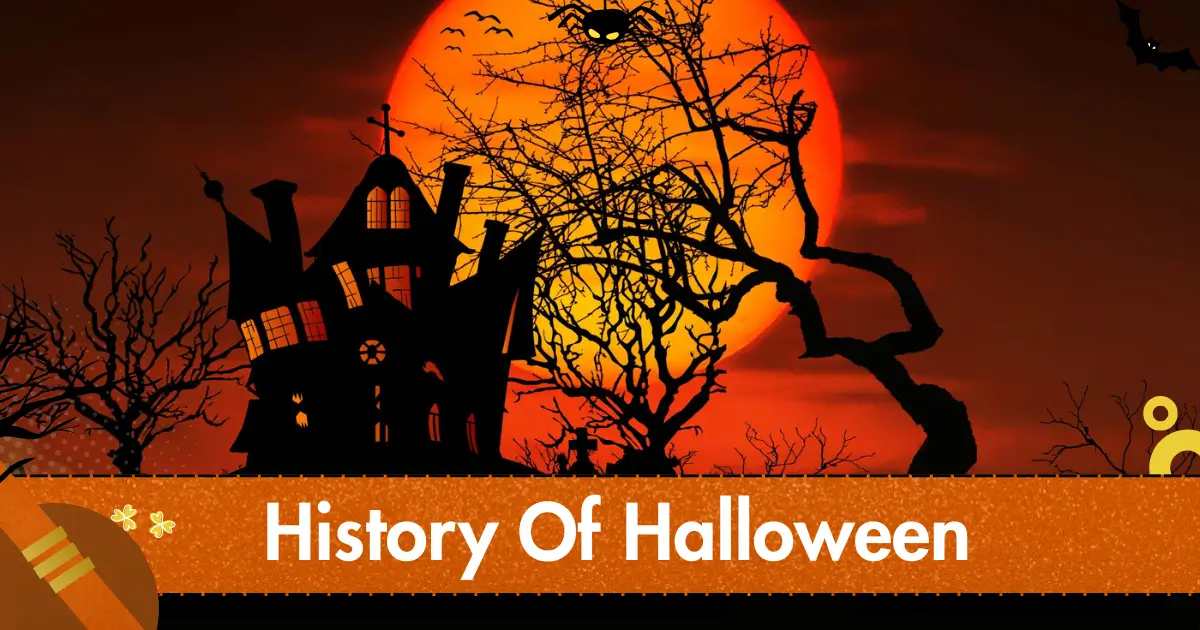2,000 years ago, on a windswept Irish hillside, flames roared skyward as tribes gathered in ritual. It was Samhain, the night the Celts believed the veil between the living and the dead was at its thinnest.
They wore animal hides. They danced around bonfires. They whispered to the shadows, hoping to guide or repel wandering spirits.
That night – rich in fear, wonder, and mystery would ignite a global tradition. Today, that same date, October 31 is marked by candy-filled bags, elaborate costumes, and a booming $12 billion industry.
But how did we get here?
In this guide, I’ll discuss Halloween’s thrilling 2,000-year evolution, from ancient Celtic rites to today’s blockbuster holiday.
You’ll know why we carve pumpkins, why children chant “trick-or-treat,” and how folklore shaped one of the most iconic nights of the year.
Let’s begin where it all started, the Celtic fire festival known as Samhain.
Celtic Dawn: The Festival of Samhain (1st Century BCE)
What Samhain Meant to the Celts
Samhain (pronounced SOW-in) marked the end of the harvest and the beginning of the “dark half” of the year. Held around November 1st, it was a sacred quarter-day festival in Gaelic tradition.
Celts believed that on Samhain, the boundary between the physical world and the spirit world faded. Spirits of the dead could return, sometimes to offer guidance, but also to stir trouble.
To protect themselves, villagers lit huge bonfires. These fires weren’t just light and warmth, they were sacred tools for protection and purification.
People wore animal hides and eerie masks, not for fun, but to confuse spirits or ward off harmful ones. These were the earliest forms of Halloween costumes.
They also left out offerings like food, drink, or small tokens to appease roaming ghosts or fairy-like creatures believed to cross over during Samhain.
Samhain wasn’t just a party. It was a spiritual event with deep ritual meaning, where fire, disguise, and offerings played a central role.
Explore these Halloween Event Names for 2025!
Symbols & Rituals That Sparked a Legacy
Many Halloween traditions trace back to early Samhain rituals:
- Mumming and Guising: People dressed in costumes and went door to door, performing songs or verses in exchange for food. This laid the foundation for trick-or-treating.
- Divination Games: Samhain also involved prophecy. People used apples, nuts, and mirrors to predict the future especially related to marriage and death.
These activities weren’t considered child’s play. They reflected real beliefs about fate and the spirit realm.
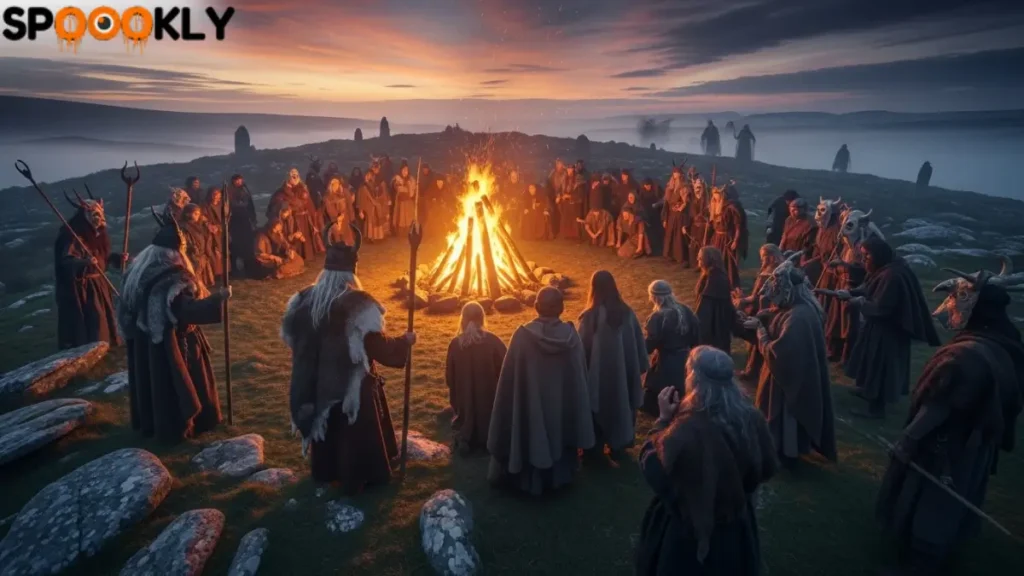
All Hallows’ Eve: The Church Rebrands a Pagan Festival (8th Century CE)
How Christianity Moved the Calendar
As Christianity spread across Europe, the Church often absorbed local traditions rather than erasing them.
In the 8th century, Pope Gregory III moved All Saints’ Day, a celebration honoring saints and martyrs to November 1. The night before became All Hallows’ Eve, and eventually, Halloween.
This wasn’t coincidence. It was strategic. By placing a Christian feast near Samhain, the Church could ease pagans into new beliefs while retaining their festivals.
Fun Fact: The term Halloween comes from “Hallowe’en,” a contraction of “All Hallows’ Evening.”
Soul Cakes, Bells & the “Souling” Tradition
By the Middle Ages, a new tradition emerged.
Poor villagers would visit homes offering prayers for the dead in exchange for soul cakes; small, round spiced pastries. This was called “souling.”
Instead of costumes, they wore black robes and carried lanterns or bells. Some would chant solemn verses at doors.
These practices may have replaced older Celtic offerings to the dead, continuing the focus on remembrance and protection.
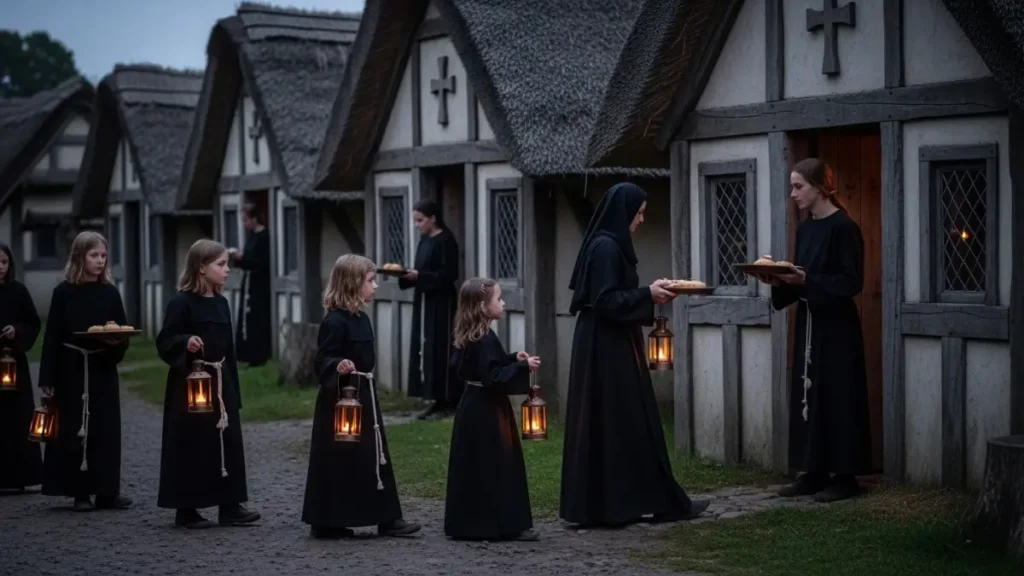
Want to do exercise on Halloween? then read this Halloween Exercises article.
From Folklore to Fear: Medieval Halloween Customs
Guising, Mumming & Mischief
Halloween didn’t vanish, it evolved. In Scotland, Ireland, and Wales, villagers kept guising alive. They dressed up in odd costumes and went door to door, performing songs, riddles, or tricks in exchange for ale, coins, or food.
But there was mischief too.
Some youths used the night for pranks disrupting farm gates, scattering cabbages, or creating minor chaos under cover of superstition.
Today’s “trick-or-treat” is rooted in this blend of performance and playful threat.
The Legend of Stingy Jack & the First “Lanterns”
One of the most enduring symbols of Halloween, the jack-o’-lantern is originated in Irish folklore.
According to legend, a man named Stingy Jack tricked the Devil and was doomed to wander the earth with only a glowing coal inside a carved turnip to light his way.
People began carving grotesque faces into turnips and placing candles inside them to ward off Jack’s spirit.
When Irish immigrants came to America, they found that pumpkins, native to North America were easier to carve. And thus, the jack-o’-lantern as we know it was born.
From Samhain to Halloween
| Era | Key Transition | Major Influence |
|---|---|---|
| 1st Century BCE | Samhain festival | Celtic fire rituals, honoring the dead |
| 8th Century CE | All Hallows’ Eve | Christian integration of pagan customs |
| Middle Ages | Souling & guising | Medieval spiritual and folk traditions |
| 1800s | Irish migration | Cultural blending in America |
| 1900s–Today | Trick-or-treat & pop culture | Commercial boom & global spread |
Crossing the Atlantic: Halloween Lands in America (1840s–1900s)
Irish Bring More Than Folklore
In the mid-19th century, a devastating potato famine pushed over a million Irish immigrants to American shores. They brought their faith, music and crucially Halloween traditions.
By the 1850s, Irish-American communities began celebrating Halloween with harvest parties, ghost stories, and turnip lanterns. These gatherings included fortune-telling games, apple bobbing, and shadowy tales of Stingy Jack and wandering spirits.
These weren’t organized parades or candy-filled events yet. They were rustic, community-based rituals filled with ancestral echoes.
Halloween gained traction in the U.S. not from marketing but from memory, mythology, and migration.
From Rural Frolics to Urban Pranks
As Halloween spread to urban neighborhoods by the late 1800s, mischief became a major theme.
Young people started flipping wagons, soaping windows, and even tipping outhouses. Newspaper headlines from the 1880s and 1890s reported Halloween vandalism from Boston to San Francisco.
Adults tried to tame the chaos by introducing structured celebrations like costume contests, school parties, and community fairs.
This shift began to reshape Halloween into a child-centered event, which paved the way for modern traditions.
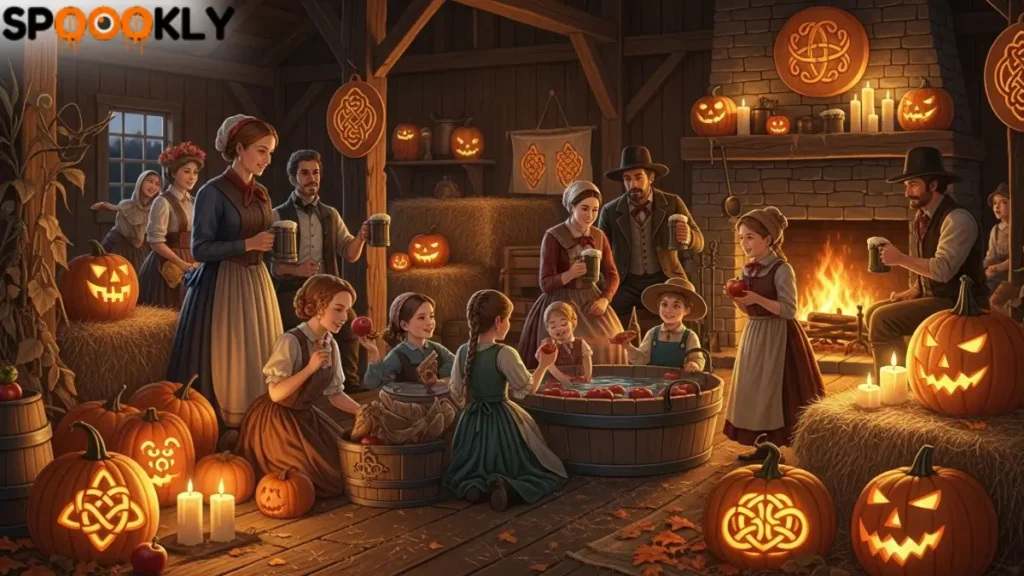
Read these Halloween Boudoir Ideas & Tips!
The Birth of Trick-or-Treat (1920s–1950s)
Where Did “Trick or Treat” Come From?
The phrase “trick or treat” first appeared in print in 1927 in Alberta, Canada. Children dressed in costumes and knocked on doors, offering a simple deal: a treat or a trick.
By the 1930s, the phrase had migrated south to the United States. And by the 1940s and 50s, it had gone mainstream.
American suburbs flush with post-war prosperity embraced Halloween as a safe, fun night for kids. Costumes became cuter. Decorations grew brighter. Streets buzzed with witches, cowboys, and pirates.
Fun Fact: The 1952 Disney cartoon Trick or Treat helped popularize the phrase nationwide.
Candy Industry Takes the Stage
Halloween didn’t always mean candy. In early decades, kids received coins, nuts, or homemade cookies. But as door-to-door trick-or-treating soared, candy companies saw an opening.
By the 1950s, manufacturers launched targeted Halloween promotions, branding their treats as pre-wrapped, safe, and easy to give. This message aligned with growing concerns about food safety and stranger danger.
Today, over $3 billion is spent annually on Halloween candy in the U.S. alone. It’s the second-largest commercial holiday after Christmas.
| Year | Halloween Candy Sales (U.S.) |
|---|---|
| 1970 | $100 million |
| 2000 | $1.5 billion |
| 2024 (projected) | $3.1 billion |
| 2025 | Will be updated after October 31st 2025 |
Costumes, Cats & Carving: Halloween Icons Explained
Jack-O’-Lanterns Go Orange
As Irish immigrants settled across the U.S., they replaced carved turnips with pumpkins easier to carve, larger, and more visually striking. The first print reference to a carved pumpkin as a “jack-o’-lantern” appeared in 1866.
Today, pumpkin carving is an art form. Every fall, towns host festivals, carving contests, and light displays. Some pumpkins weigh over 2,000 pounds, earning them a spot in world records.
Black Cats & Ancient Superstitions
In medieval Europe, black cats were often associated with witches and bad omens. Many believed they were familiars, supernatural animals that assisted witches.
This superstition traveled with European settlers. Even now, some shelters pause black cat adoptions near Halloween to prevent abuse.
Note: Not everyone sees black cats as unlucky. In some cultures, they’re symbols of protection and good fortune.
Costume Boom of the 20th Century
The modern costume industry took off in the 1930s, with companies like Ben Cooper Inc. mass-producing inexpensive masks and outfits for kids.
By the 1980s and 1990s, Halloween exploded into a full-blown costume spectacle with adults joining in.
Today, cosplay, horror fandoms, and pop-culture characters dominate costume trends, with Marvel superheroes, classic monsters, and nostalgic icons leading the pack.
Top-Selling Costumes (2024 Projection)
- Witch
- Vampire
- Spider-Man
- Wednesday Addams
- Barbie & Ken
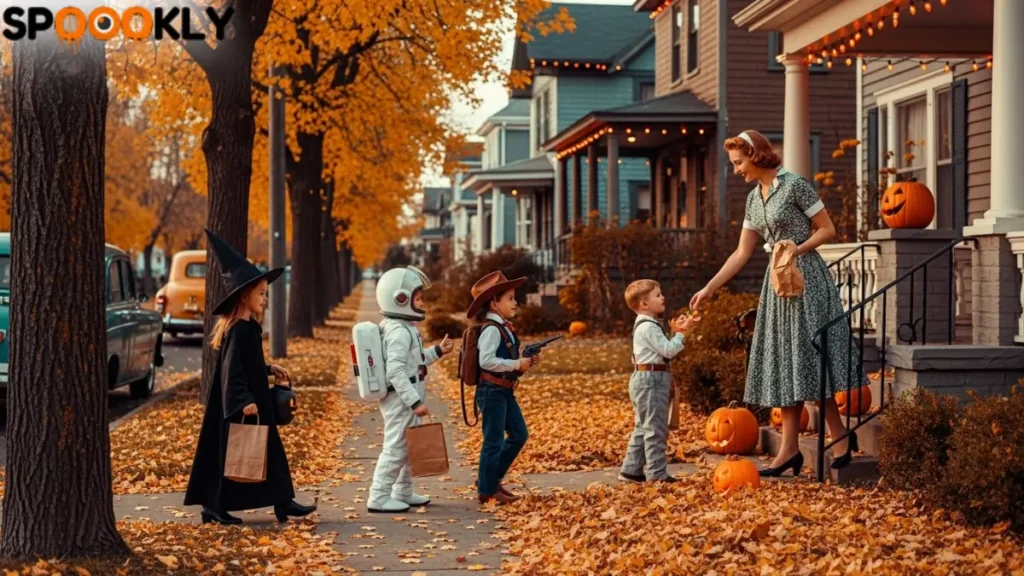
Explore these Best Halloween Quotes for Kids!
Commercial & Pop-Culture Explosion (1950s–Today)
Halloween Goes Hollywood
By the 1950s, Halloween had fully entered the American mainstream. But it wasn’t until media and pop culture embraced the holiday that it truly became unstoppable.
TV shows like Casper the Friendly Ghost, It’s the Great Pumpkin, Charlie Brown, and Scooby-Doo built Halloween into a visual tradition.
Then came slasher films. Titles like Halloween (1978) and Friday the 13th turned the holiday into a cinematic event. These movies redefined the imagery: haunted houses, masked villains, and fog-drenched cemeteries.
Theme parks jumped in too. Knott’s Scary Farm and Universal Halloween Horror Nights drew millions with immersive horror experiences.
Halloween became more than a tradition. It became a franchise.
Price Tag of Fear: Halloween by Numbers
Halloween is now a $12.2 billion industry in the U.S. (2024 projection, NRF data).
Here’s where people spend:
| Category | 2024 Estimated Spend |
|---|---|
| Costumes | $3.6 billion |
| Candy | $3.1 billion |
| Decorations | $3.9 billion |
| Greeting Cards | $0.5 billion |
| Other (Events, Attractions) | $1.1 billion |
Halloween is now the second biggest retail holiday in the U.S. after Christmas.
Inclusive, Eco-Friendly, and Modern Trends
As the holiday grows, so do concerns and improvements.
Sustainable Celebrations
More people are choosing:
- Reusable costumes
- DIY décor from recycled materials
- LED lights instead of energy-hungry displays
Retailers now offer biodegradable packaging and secondhand costume racks to cut down on landfill waste.
Inclusive Halloween: Everyone Belongs
Families with children who have allergies are embracing the Teal Pumpkin Project, a movement promoting non-food treats like stickers and toys.
There’s also a rise in:
- Adaptive costumes for kids with mobility devices
- Sensory-friendly events for those on the autism spectrum
- Diverse costume options reflecting broader cultural identities
Halloween is no longer just scary, it’s smarter, safer, and more inclusive.
How Other Cultures Honor the Dead?
While Halloween feels uniquely American now, its themes are echoed worldwide.
Día de los Muertos (Mexico)
Held from October 31 to November 2, this celebration honors deceased loved ones with altars, marigolds, candles, and favorite foods. It blends Aztec beliefs with Catholic All Saints’ traditions.
Obon (Japan)
Celebrated in summer, Obon welcomes the spirits of ancestors back home with lanterns, bon dances, and ancestral altars.
Guy Fawkes Night (UK)
Observed on November 5, it’s known for bonfires, fireworks, and masks, originally to mark the failed Gunpowder Plot of 1605. While not spirit-focused, it echoes Halloween’s love for flame and disguise.
While names differ, many cultures hold space to honor the dead and light the night in remembrance.
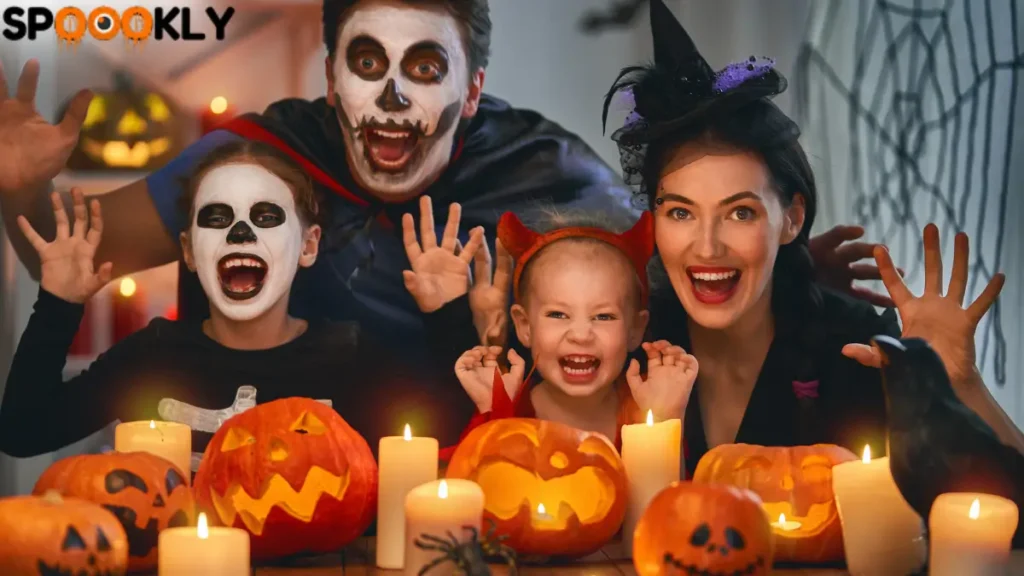
Modern Debates & Myth-Busting
Who Really “Owns” Halloween Pagans or Christians?
Some say Halloween is a pagan holiday, rooted in Samhain’s ancient fire rituals. Others argue it’s a Christian holy eve, born from All Saints’ Day.
The truth? It’s both and neither entirely.
Halloween is a layered tradition. Samhain gave it fire and spirits. Christianity added saints and prayers. America brought candy, costumes, and commercial magic.
Religious groups sometimes reject Halloween, citing its pagan past or perceived occult imagery. But many churches now host trunk-or-treats as safe, family-friendly alternatives.
Halloween isn’t just pagan or Christian, it’s a cultural hybrid shaped by history, belief, and community.
Myth: Halloween Is Dangerous for Kids
Every year, warnings spread across social media: razor blades in apples, fentanyl disguised as candy, poisoned treats.
Let’s break it down.
According to multiple studies, confirmed cases of Halloween candy tampering are almost nonexistent. The National Safety Council and Snopes.com have tracked decades of these rumors, most are unfounded or media-fueled panic.
More real risks?
- Traffic accidents: Halloween is statistically the deadliest night for pedestrian fatalities involving children.
- Poor visibility from dark costumes or unlit streets.
- Allergic reactions to unlabelled treats.
Solution: Use reflective tape, supervise trick-or-treating, and join allergy-safe programs like the Teal Pumpkin Project.
2,000 Years in One Glance: Halloween Timeline
Here’s a historical snapshot showing how Halloween evolved through the centuries:
| Year / Era | Event / Milestone |
|---|---|
| 1st Century BCE | Samhain celebrated by Celts in Ireland |
| 8th Century CE | All Saints’ Day moved to Nov 1 by Pope Gregory III |
| 1000s CE | “Souling” begins across medieval Europe |
| 1600s | Stingy Jack folktale circulates in Ireland |
| 1840s | Irish immigrants bring Halloween to America |
| 1866 | First recorded use of “jack-o’-lantern” in print |
| 1927 | “Trick or treat” appears in Canadian newspaper |
| 1930s–40s | Trick-or-treating spreads across the U.S. |
| 1950s | Halloween becomes kid-focused; candy marketing begins |
| 1978 | Horror film Halloween launches franchise |
| 1990s–2000s | Pop culture and adult costume parties boom |
| 2024 | Halloween spending hits $12.2 billion in U.S. |
| 2025 | Coming on 31st October |
Fun Facts About Halloween
- Apple bobbing started as a romantic matchmaking game in Celtic Britain.
- Pumpkins used in jack-o’-lanterns were a New World substitute for turnips.
- Illinois grows over 90% of all processed pumpkins in the U.S.
- The largest Halloween parade in the world is in Greenwich Village, NYC, attracting 50,000+ costumed participants annually.
- Reese’s Cups consistently rank as America’s #1 favorite Halloween candy.
Conclusion
Halloween didn’t appear out of thin air. It evolved.
From the sacred bonfires of ancient Samhain to the bustling, candy-filled streets of today, it’s traveled a long and strange road.
Religious reformations, folklore, immigration, media, and commerce all left their mark. What started as a pagan ritual to honor the dead is now a vibrant blend of memory, mischief, and marketing.
And still, it carries echoes of its past, lanterns glowing against the night, disguises to confuse spirits, and that electric thrill in the air.
On Spoookly.com, our mission is to celebrate this timeless tradition with guides, inspiration, and everything spooky in between.
So whether you’re a history nerd, a horror fan, or just here for the candy, this holiday still has room for everyone.
FAQs
Halloween originated from Samhain, an ancient Celtic festival celebrated over 2,000 years ago in Ireland. It marked the end of the harvest and the belief that spirits could roam freely.
Pumpkin carving comes from an Irish folktale about Stingy Jack, who roamed the earth with a glowing coal in a carved turnip. When Irish immigrants came to the U.S., they found pumpkins easier to carve.
The term “trick or treat” first appeared in Canada in 1927, but became popular in the U.S. during the 1930s and 1950s, especially as suburban culture and candy marketing grew.
Halloween blends both. It originated from pagan Samhain, but was reshaped by Christian All Saints’ Day. Today, it’s more of a cultural celebration than a strictly religious one.
In the U.S., Halloween spending in 2024 is projected to hit $12.2 billion, including costumes, candy, decorations, and events making it one of the top-grossing holidays after Christmas.

